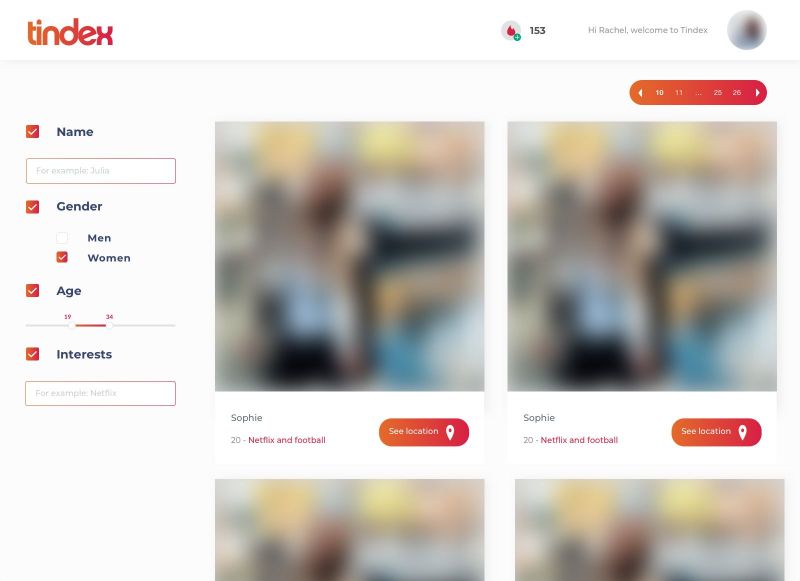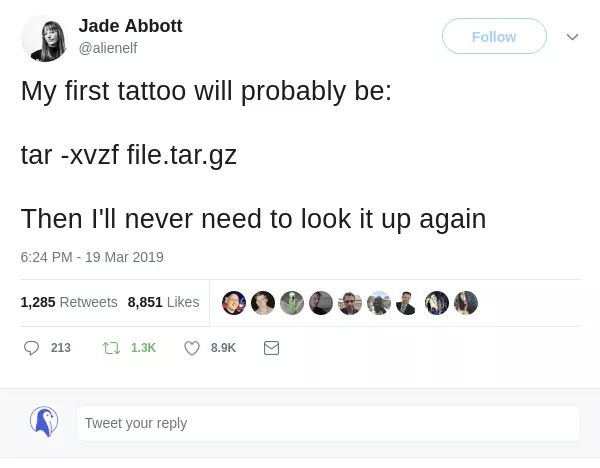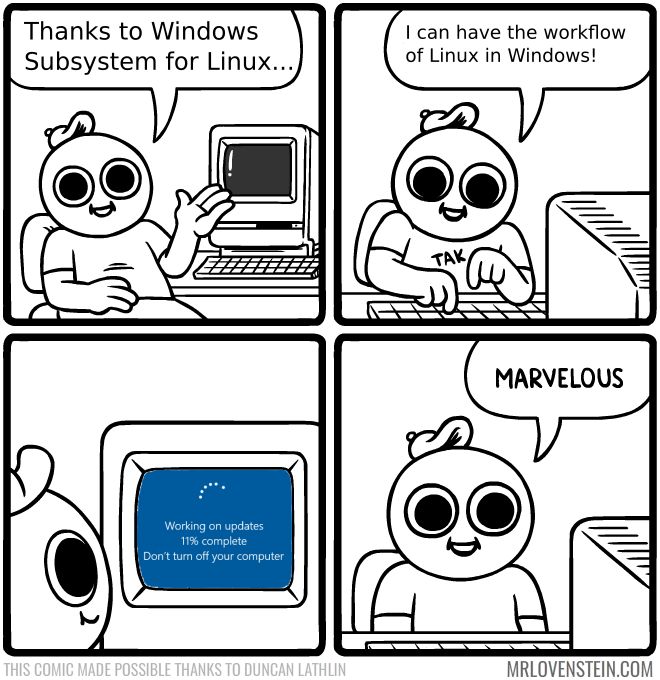Details
-
AboutWent through sys- and networkadmin as well as being a programmer to end up in IT-Security I love cryptography, and things close to Hardware :) I do gaming & roleplay too. Specs: 7900X | 4090 | 64GB RAM | W11 :/
-
SkillsC and Python with some Natural and Java
-
LocationDUS, GRZ, VIE, MUC, TXL
-
Website
-
Github
Joined devRant on 10/31/2016
Join devRant
Do all the things like
++ or -- rants, post your own rants, comment on others' rants and build your customized dev avatar
Sign Up
Pipeless API

From the creators of devRant, Pipeless lets you power real-time personalized recommendations and activity feeds using a simple API
Learn More
-
Vim:
1. It doesn't matter on which server I ssh, I'll have vim, if not I can install it. So I get the same work efficiency I would get on my pc
2. It has a predictible behavior - u don't have to think which keybind is where, or how to do something.
3. Sky is the limited if you want to customize2 -
Project Leader: the team needs to use Git
Dev team: yeah Git, it will help us a lot
.
.
.
[three days later]
Dev: we send the changes via Dropbox, see you on monday! 7
7 -
This one is for devs and gamers.
But first some background story.
My girlfriend is special. Not just generically lovey mush mush special. She is 1 in 100 more accurately 1 in 10000. She was born with a rare Congenital Heart Defect {CHD}. Called Truncus Arteriosus or TA for sake of brevity. TA's main thing is the two main arteries going into the heart are fused together and never seperated at birth. It's bad news. There is no cure for this kind of thing. Simply repairs that happen over the course of life.
So here is me. Desperately trying to find a way to get the word about this and the 40 other types of CHD out there in the world. I thought. "What if I make a game..." Not based around the medical jargon but on a level people could understand. I spent the better part of the last six years attending appointments with her and still don't get it. What I do get is her Emotional state. How her CHD causes her to think and feel.
So here is the pitch.
The game is about a girl who is diagnosed at birth with a CHD. She is now in her 20's and has to undergo an open heart surgery to repair the defect. The day comes. She goes under but when she wakes up she find herself in a final fantasy style environment. This new world has a darkness cast over it. She is unknowingly the hero of this world and she has to face off with multiple bosses of varied degrees of evil.
Then after beating these bosses she really wakes up from the surgery. Waking up to the realization that the world she saved was herself. And all the bosses were manifestations of her own internal feelings. Depression, anxiety, hopelessness, Denise, desire and so on.
I would sell this game with the caveat that 2/3 of all profits get split between the Adult Congenital Heart Association and Project Heart. As those are the two main organizations that deal heavily with creating standards of care and raising awareness for CHD survivors.
Thoughts?
Note: I am still learning game dev. This is an eventual goal for me.33 -
In my previous rant about IPv6 (https://devrant.com/rants/2184688 if you're interested) I got a lot of very valuable insights in the comments and I figured that I might as well summarize what I've learned from them.
So, there's 128 bits of IP space to go around in IPv6, where 64 bits are assigned to the internet, and 64 bits to the private network of end users. Private as in, behind a router of some kind, equivalent to the bogon address spaces in IPv4. Which is nice, it ensures that everyone has the same address space to play with.. but it should've been (in my opinion) differently assigned. The internet is orders of magnitude larger than private networks. Most SOHO networks only have a handful of devices in them that need addressing. The internet on the other hand has, well, billions of devices in it. As mentioned before I doubt that this total number will be more than a multiple of the total world population. Not many people or companies use more than a few public IP addresses (again, what's inside the SOHO networks is separate from that). Consider this the equivalent of the amount of public IP's you currently control. In my case that would be 4, one for my home network and 3 for the internet-facing servers I own.
There's various ways in which overall network complexity is reduced in IPv6. This includes IPSec which is now part of the protocol suite and thus no longer an extension. Standardizing this is a good thing, and honestly I'm surprised that this wasn't the case before.
Many people seem to oppose the way IPv6 is presented, hexadecimal is not something many people use every day. Personally I've grown quite fond of the decimal representation of IPv4. Then again, there is a binary conversion involved in classless IPv4. Hexadecimal makes this conversion easier.
There seems to be opposition to memorizing IPv6 addresses, for which DNS can be used. I agree, I use this for my IPv4 network already. Makes life easier when you can just address devices by a domain name. For any developers out there with no experience with administration that think that this is bullshit - imagine having to remember the IP address of Facebook, Google, Stack Overflow and every other website you visit. Add to the list however many devices you want to be present in the imaginary network. For me right now that's between 20 and 30 hosts, and gradually increasing. Scalability can be a bitch.
Any other things.. Oh yeah. The average amount of devices in a SOHO network is not quite 1 anymore - there are currently about half a dozen devices in a home network that need to be addressed. This number increases as more devices become smart devices. That said of course, it's nowhere close to needing 64 bits and will likely never need it. Again, for any devs that think that this is bullshit - prove me wrong. I happen to know in one particular instance that they have centralized all their resources into a single PC. This seems to be common with developers and I think it's normal. But it also reduces the chances to see what networks with many devices in it are like. Again, scalability can be a bitch.
Thanks a lot everyone for your comments on the matter, I've learned a lot and really appreciate it. Do check out the previous rant and particularly the comments on it if you're interested. See ya!25 -
People having sleep deprivation.
If your health is at stake, you may want to aim for maximum healing potential.
Humen always should prefer more natural substances and techniques.
As chemicals mostly alter the status quo but tackle the ultimate reason why.
Military has developed glasses that simulate the sunrise to wake you up / keep you awake.
That technique is like 20 years old. And who is gonna get those glasses for me?
Nowadays, studies published find humen feel more at ease by rising and sleeping with the sun and moon.
Having two weeks of camping once in a while is recommended. At least once a year.
Alternately you can try to regulate your days rhythm.
Start your day with a cup of hot speedwell tea.
Like every freaking day.
Its augmenting your activity thus easing your sleep at night.
Give every technique at least two weeks time to take effect.
And always remember :
Sleep is a thing that can be influenced but never will be controlled.
Good night ;P9 -
All crypt!
Blamed my brother giving me computer blue waffles over the just plugged drive and it'd be crypting all files.
Turned out I lose SATA of my primary drive.
Cussing 1/2h for a sincere excuse.
Thx 4 being the brother you are, brother. 1
1 -
Last year I built the platform 'Tindex'. It was an index of Tinder profiles so people could search by name, gender and age.
We scraped the Tinder profiles through a Tinder API which was discontinued not long ago, but weird enough it was still intact and one of my friends who was also working on it found out how to get api keys (somewhere in network tab at Tinder Online).
Except name, gender and age we also got 3 distances so we could calculate each users' location, then save the location each 15 minutes and put the coordinates on a map so users of Tindex could easily see the current location of a specific Tinder user.
Fun note: we also got the Spotify data of each Tinder user, so we could actually know on which time and which location a user listened to a specific Spotify track.
Later on we started building it out: A chatbot which connected to Tinder so Tindex users could automatically send a pick up line to their new matches (Was kinda buggy, sometimes it sent 3 pick up lines at ones).
Right when we started building a revenue model we stopped the entire project because a friend of ours had found out that we basically violated almost all terms.
Was a great project, learned a lot from it and actually had me thinking twice or more about online dating platforms.
Below an image of the user overview design I prototyped. The data is mock-data. 51
51 -
Today I learned:
`/usr` stands for “universal system resources” not “user”
`/dev` stands for “device” not “development”
Had no idea.31 -
--- Save some time with Google's .new-Domains ---
A few days ago, Google announced their new '.new' domains.
By using them you can save plenty of time when creating new Docs, Sheets, Slides, Sites or Forms.
So instead of going to Google Drive and creating the document there, users can just input the corresponding URL into the browser!
Here are a few examples:
> 'doc.new' or 'docs.new' or 'documents.new' to create a new Google Docs document (https://doc.new/)
> 'sheet.new' or 'sheets.new' or 'spreadsheet.new' to create a new Google Spreadsheets document (https://sheet.new/)
> 'site.new' or 'sites.new' or 'website.new' to create a new Google Sites website (https://site.new/)
> 'slide.new' or 'slides.new' or 'deck.new' or 'presentation.new' to create a new Google Slides document (https://slide.new/)
> 'form.new' or 'forms.new' to create a new Google Forms form (https://form.new/)
This is also useful for creating special bookmarks in the browser! 34
34 -
Whenever I come across some acronyms...
CD-ROM: Consumer Device, Rendered Obsolete in Months
PCMCIA: People Can’t Memorize Computer Industry Acronyms
ISDN: It Still Does Nothing
SCSI: System Can’t See It
MIPS: Meaningless Indication of Processor Speed
DOS: Defunct Operating System
WINDOWS: Will Install Needless Data On Whole System
OS/2: Obsolete Soon, Too
PnP: Plug and Pray
APPLE: Arrogance Produces Profit-Losing Entity
IBM: I Blame Microsoft
MICROSOFT: Most Intelligent Customers Realize Our Software Only Fools Teenagers
COBOL: Completely Obsolete Business Oriented Language
LISP: Lots of Insipid and Stupid Parentheses
MACINTOSH: Most Applications Crash; If Not, The Operating System Hangs10
















